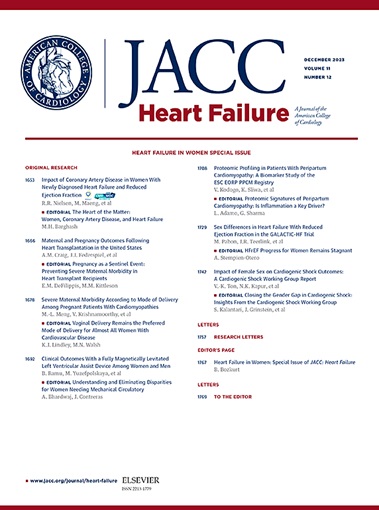Effects of Glucagon-Like Peptide 1 Receptor Agonist Initiation in Patients With Heart Failure With Reduced Ejection Fraction and Implantable Cardiac Devices
IF 11.8
1区 医学
Q1 CARDIAC & CARDIOVASCULAR SYSTEMS
引用次数: 0
Abstract
Background
Glucagon-like peptide 1 receptor agonists (GLP1RAs) may increase heart rate in patients with heart failure with reduced ejection fraction (HFrEF), which could induce deleterious effects in this population. Information retrieved from implanted cardiac devices may provide more insights into GLP1RA-associated effects on heart rate and arrhythmic events.
Objectives
This study aims to analyze the effects of GLP1RA on device-related rhythm parameters in patients with HFrEF and implanted cardiac devices.
Methods
The authors performed a retrospective analysis of outpatients with HFrEF with implanted cardiac devices followed in cardiorenal clinics from a single-center quaternary care hospital in Canada. GLP1RA users were compared with GLP1RA nonusers with similar baseline characteristics for longitudinal changes (1-year follow-up) in heart rate, using data from electrophysiology interrogation reports. Secondary endpoints included relevant arrhythmic events, changes in body mass index (BMI), and laboratory biomarkers.
Results
Among 253 patients with HFrEF and implanted cardiac devices, 53 new GLP1RA users were compared with 53 GLP1RA nonusers. The mean age was 66 ± 10 years, 81% were men, 93% had diabetes, and 36% had atrial fibrillation. The mean BMI was 31.4 kg/m2, and the mean ejection fraction was 28% ± 10%. After adjustment, GLP1RA use (vs no use) significantly increased heart rate by +7 beats/min (95% CI: 4-10 beats/min; P < 0.01). GLP1RA use (vs no use) was associated with a numeric increase in ventricular tachycardia/fibrillation events (13 vs 2; P = 0.07) and a significant increase in nonsustained ventricular events and total shock/antitachycardia pacing therapies (33 vs 3; P = 0.01).
Conclusions
In this retrospective analysis of patients with HFrEF and implanted cardiac devices, GLP1RA use was associated with significant increase in heart rate and increased number of nonsustained ventricular events and total shock/antitachycardia pacing therapies. These findings highlight the need for further evaluation of GLP1RA use in HFrEF.
胰高血糖素样肽1受体激动剂在心力衰竭伴射血分数降低和植入式心脏装置患者中的作用
胰高血糖素样肽1受体激动剂(GLP1RAs)可能会增加心力衰竭伴射血分数降低(HFrEF)患者的心率,这可能在这一人群中引起有害影响。从植入的心脏装置中获取的信息可能为glp1ra对心率和心律失常事件的相关影响提供更多的见解。目的本研究旨在分析GLP1RA对HFrEF和植入心脏装置患者的器械相关节律参数的影响。方法回顾性分析加拿大一家单中心第四保健医院心脏肾门诊植入心脏装置的HFrEF患者。使用电生理审讯报告的数据,将GLP1RA使用者与具有相似基线特征的GLP1RA非使用者进行心率纵向变化(1年随访)的比较。次要终点包括相关的心律失常事件、体重指数(BMI)的变化和实验室生物标志物。结果在253例HFrEF和植入心脏装置的患者中,53例新的GLP1RA使用者与53例未使用GLP1RA的患者进行了比较。平均年龄66±10岁,81%为男性,93%为糖尿病,36%为房颤。平均BMI为31.4 kg/m2,平均射血分数为28%±10%。调整后,使用GLP1RA(与未使用GLP1RA相比)显著提高心率+7次/分钟(95% CI: 4-10次/分钟;P < 0.01)。GLP1RA的使用(与未使用相比)与室性心动过速/颤动事件的数字增加(13 vs 2, P = 0.07)以及非持续性心室事件和总休克/抗心动过速起搏治疗的显着增加(33 vs 3, P = 0.01)相关。结论:在这项对HFrEF和植入心脏装置患者的回顾性分析中,GLP1RA的使用与心率显著增加、非持续性心室事件数量增加以及全休克/抗心动过速起搏治疗相关。这些发现强调了进一步评估GLP1RA在HFrEF中的应用的必要性。
本文章由计算机程序翻译,如有差异,请以英文原文为准。
求助全文
约1分钟内获得全文
求助全文
来源期刊

JACC. Heart failure
CARDIAC & CARDIOVASCULAR SYSTEMS-
CiteScore
21.20
自引率
2.30%
发文量
164
期刊介绍:
JACC: Heart Failure publishes crucial findings on the pathophysiology, diagnosis, treatment, and care of heart failure patients. The goal is to enhance understanding through timely scientific communication on disease, clinical trials, outcomes, and therapeutic advances. The Journal fosters interdisciplinary connections with neuroscience, pulmonary medicine, nephrology, electrophysiology, and surgery related to heart failure. It also covers articles on pharmacogenetics, biomarkers, and metabolomics.
 求助内容:
求助内容: 应助结果提醒方式:
应助结果提醒方式:


